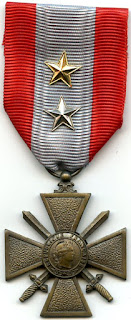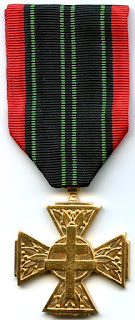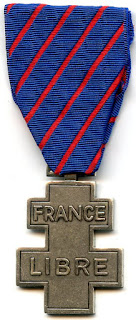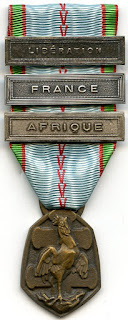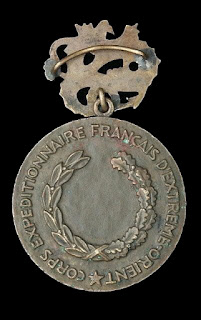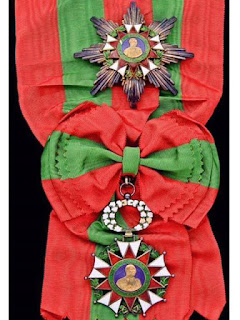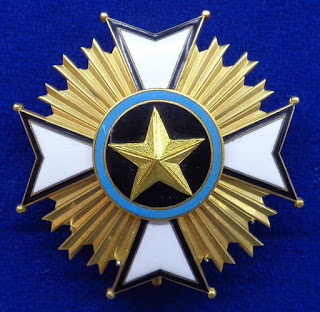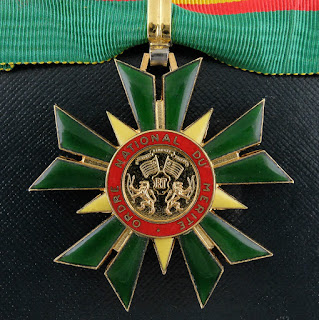 |
| 10000 francs Bokassa banknote |
 |
| African banknotes 10000 francs |
African States banknotes 10000 Francs CFA banknote Bokassa, French-printed banknotes images, African States Bokassa banknotes, African States paper money, African States bank notes.
Obverse: Portrait of President of the Central African Republic Jean-Bédel Bokassa in parade uniform wearing all his impressive collection of military decorations( Legion of Honour, War Cross for foreign operational theaters, Cross of Lorraine, and many others), the panoramic view of the Rock Hotel in Bangui, Central African Republic.
Reverse: Farmer on his tractor plowing the field. African hand carved wood figurines.
His Excellency Jean Bedel Bokassa, Emperor of the Central African Empire. He wore many orders and decorations and medals too in his magnificent uniforms:
France: Grand Cross of the Order of the Legion of Honour
France: Recipient of the Military Medal
France: Recipient of the Cross of War Medal of 1939-1945
France: Recipient of the Cross of War Medal of Foreign Operation
France: Recipient of the Volunteer Combatant Cross Medal of 1939-1945
France: Recipient of the Volunteer Combatant Resistance Cross Medal
France: Recipient of the Overseas Medal
France: Recipient of the Free France Voluntary Service Commemorative Medal
France: Recipient of the 1939–1945 Commemorative War Medal
France: Recipient of the Commemorative Medal for the Indochina Campaign
Central African Empire House of Bokassa: Sovereign Knight Grand Cordon with Collar of the Imperial Order of Bokassa (Grand Cross of the Order of Operation Bokassa, Central African Empire)
Central African Empire House of Bokassa: Sovereign Knight Grand Cordon of the Imperial Order of Central African Merit
Central African Empire House of Bokassa: Sovereign Knight Commander of the Imperial Order of Agricultural Merit, 1st Class
Central African Empire House of Bokassa: Sovereign Knight of the Imperial Order of Central African Recognition, 1st Class
Cameroon: Grand Cross of the Order of Valour
Chad: Grand Cross of the National Order of Chad
Congo: Grand Cross of the Order of Merit
Egypt: Grand Cross with Collar of the Order of the Nile
Gabon: Grand Cross of the Order of the Equatorial Star
Ivory Coast: Grand Cross of the National Order of the Ivory Coast
Madagascar: Grand Cross of the National Order of the Republic of Madagascar
Morocco: Knight Grand Cross with Collar of the Order of Ouissam Alaouite
Libya: Grand Cross of the Order of the Republic, Libya
Senegal: Grand Cross of the Order of the Lion, Senegal
Sudan: Grand Cross of the Order of the Two Niles, Sudan
Togo: Grand Cross of the National Order of Merit of Togo
Tunisia: Grand Cross with Collar of the Order of Independence, Tunisia
Yugoslavia: Grand Cross of the Order of the Yugoslav Star, Great Star
Zaire: Grand Cross of the National Order of the Leopard
Legion of Honour
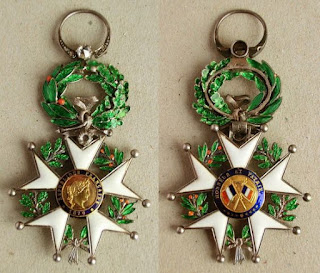 The Legion of Honour, full name, National Order of the Legion of Honour (French: Ordre national de la Légion d'honneur), is the highest French order of merit for military and civil merits, established in 1802 by Napoléon Bonaparte.
The Legion of Honour, full name, National Order of the Legion of Honour (French: Ordre national de la Légion d'honneur), is the highest French order of merit for military and civil merits, established in 1802 by Napoléon Bonaparte.The order's motto is "Honneur et Patrie" ("Honour and Fatherland") and its seat is the Palais de la Légion d'Honneur next to the Musée d'Orsay, on the left bank of the River Seine in Paris.
The order is divided into five degrees of increasing distinction: Chevalier (Knight), Officier (Officer), Commandeur (Commander), Grand Officier (Grand Officer) and Grand-Croix (Grand Cross).
- Chevalier (Chev. L.H.) (Knight): minimum 20 years of public service or 25 years of professional activity with "eminent merits"
- Officier (O.L.H.) (Officer): minimum 8 years in the rank of Chevalier
- Commandeur (Cdr L.H.) (Commander): minimum 5 years in the rank of Officier
- Grand Officier (G.O.L.H.) (Grand Officer): minimum 3 years in the rank of Commandeur
- Grand Croix (G.C.L.H.) (Grand Cross): minimum 3 years in the rank of Grand Officier
The "eminent merits" required to be awarded the order require the flawless performance of one's trade as well as doing more than ordinarily expected, such as being creative, zealous and contributing to the growth and well-being of others.
The order has a maximum quota of 75 Grand Cross, 250 Grand Officers, 1,250 Commanders, 10,000 Officers, and 113,425 (ordinary) Knights. As of 2010, the actual membership was 67 Grand Cross, 314 Grand Officers, 3,009 Commanders, 17,032 Officers and 74,384 Knights. Appointments of veterans of World War II, French military personnel involved in the North African Campaign and other foreign French military operations, as well as wounded soldiers, are made independently of the quota.
Members convicted of a felony (crime in French) are automatically dismissed from the order. Members convicted of a misdemeanour (délit in French) can be dismissed as well, although this is not automatic.
Wearing the decoration of the Légion d'honneur without having the right to do so is a serious offence. Wearing the ribbon or rosette of a foreign order is prohibited if that ribbon is mainly red, like the ribbon of the Legion of Honour. French military personnel in uniform must salute other military members in uniform wearing the medal, whatever the Légion d'honneur rank and the military rank of the bearer. This is not mandatory with the ribbon. In practice, however, this is rarely done.
There is not a single, complete list of all the members of the Legion in chronological order. The number is estimated at one million, including about 2,900 Grand Cross.
Military Medal
The Médaille militaire (English: Military Medal) is a military decoration of the French Republic for other ranks for meritorious service and acts of bravery in action against an enemy force. It is the third highest award of the French Republic, after the Légion d'honneur, a civil and military order, and the ordre de la Libération, a second world war-only order. The Médaille militaire is therefore the most senior entirely military active French decoration.
During World War One, 230000 médailles were awarded, when 1400000 French Army soldiers were killed and 3000000 wounded. For comparison, the UK Military Medal was awarded on 115000 occasions in World War One, when 673375 British Army soldiers were killed and 1643469 wounded.
The award was first established in 1852 by the first President of the French Republic, Louis-Napoléon Bonaparte who may have taken his inspiration from a medal established and awarded by his father, Louis Bonaparte, King of Holland.
After the First World War, the Military Medal was also temporarily awarded for wounds received in combat.
French War Cross 1939-1945
The Croix de guerre 1939–1945 (War Cross 1939–1945) is a French military decoration, a version of the Croix de guerre created on September 26, 1939, to honour people who fought with the Allies against the Axis forces at any time during World War II.
Due to the large extent of the war zone, recipients included those who fought during, with, at, or in the following:
- Battle of France
- French Forces of the Interior
- Free French Forces
- Western Front,
- Middle East Theater
- Mediterranean Theater
- African campaigns
Cross of War Medal of Foreign Operation
The Croix de guerre des théâtres d'opérations extérieurs (War Cross for foreign operational theatres), also called the Croix de Guerre TOE for short, is a French military award denoting citations earned in combat in foreign countries. The Armistice of November 11, 1918 ended the war between France and Germany, but French soldiers continued fighting in theatres outside metropolitan France. Combat operations continued in Syria, Palestine, Constantinople, Morocco, French West Africa and French Equatorial Africa.
History
A law was passed on April 30, 1921 establishing the new Croix de guerre for "Théâtres d'opérations extérieurs" (TOE). It was intended to commemorate the individual citations awarded during operations carried out since November 11, 1918 or that would occur in the future, for war service directly related to an expeditionary force used outside of the borders of France, otherwise, the statute of the Croix de guerre TOE was the same as that of the 1914 - 1918 Croix de guerre.
Following the combat operations of the immediate post World War 1 Era, the Croix de Guerre TOE was again awarded for actions in Indochina, Madagascar, Korea, and during the Suez Crisis.
After a hiatus of thirty-five years, it was again awarded for actions between January 17, 1991 and May 5, 1992 during the Gulf War (Order of Minister of Defence of 17 January 1991). It was also extended to military operations conducted in Kosovo in 1999.
Statute
The award criteria for the Croix de Guerre TOE are substantially the same as those governing the Croix de Guerre 1914-1918, the citations for the entire armed forces are made by the Minister of Defense unless this authority has been specially delegated to the commanding general of the expeditionary forces.
The Croix de Guerre TOE is awarded to military personnel and civilians who have received an individual citation during war/combat operations on foreign soil. More precisely, it was awarded for citations earned in the following operational foreign theatres:
- The Levant in 1918 and 1919, in the East from 1918 to 1920 in Morocco in 1918;
- French Equatorial Africa (AEF) in 1919;
- French West Africa (FWA) from 1918 to 1921;
- Morocco (Rif War) of 1921-1926;
- Indochina in 1918-1922 and 1945–1954;
- for military missions in the Baltic countries (Estonia, Latvia, Lithuania), Upper Silesia, Poland, Czechoslovakia, Russia, the Caucasus, Siberia, Hungary and Romania;
- Madagascar in 1947;
- Korea from 1950 to 1953;
- The Middle East (Egypt from 30 October 1956 to 31 December 1956 and the Gulf War of 17 January 1991 to 5 May 1992);
- Federal Republic of Yugoslavia (Kosovo from 24 March 1999 to 21 June 1999).
Volunteer Combatant Cross Medal of 1939-1945
The Volunteer combatant's cross (French: "Croix du combattant volontaire") was a French decoration that originally recognized those who volunteered to serve in a combat unit during World War II. It is the equivalent of the "1914-1918 Volunteer combatant's cross" (French: "Croix du Combattant Volontaire 1914–1918").
History
This decoration is equivalent to that awarded to the soldiers of the First World War. At the request of the associations of veterans the state fixed by Act of 4 February 1953, accompanied by a decree of 19 November 1955, the award Croix du Combattant Volontaire 1939–1945, designated for those who volunteered to serve. In 1983 the original act establishing this award has the "1939-1945 Volunteer combatant's cross" (French: "Croix du combattant volontaire 1939-1945")was abolished and replaced by an act that added clasps to the medal, specifying the specific areas of combat, and renaming it more simply to "Volunteer combatant's cross" . Additional revisions of the act establishing this award in 1995 and 2007 have added a total of five clasps:
- Guerre 1939–1945
- Indochine
- Corée
- Afrique du Nord
- Missions extérieures
Description of the medal
A cross with four arms in bronze, 36 mm wide. Engraved by Frédéric de Vernon.
On the obverse: a round central medallion with the legend surrounding REPUBLIQUE FRANCAISE:
- Effigy of a helmeted Poilu (World War I infantryman), on a sword drawn vertically on the arms of the cross which is covered with laurel leaves and oak leaves in relief.
On the reverse: inside the central medallion, a branch of laurel is surrounded by the inscription: COMBATTANT VOLONTAIRE 1939–1945. The reverse of the 1983 version has no date. The cross arms are covered with leaves of laurel and oak forming relief.
Eligibility
The Volunteer combatant's cross was created to honor those who voluntarily participated in an armed conflict, during which they put their lives at risk.
In this spirit, the candidate for this distinction must provide proof from what he has done is a voluntary act of serving in a combat unit, so that because of his age or his circumstances, he was compelled to any "service obligation" (read "no obligation such "). From what he has in fact been present in a unit recognized fighter, during a specified time.
The Volunteer combatant's cross is considered a war decoration during the review of applications for Légion d'honneur, la Médaille militaire and l'Ordre national du Mérite.
Volunteer Combatant Resistance Cross Medal
The Cross of the resistance volunteer combatant (French: "Croix du combattant volontaire de la Résistance") is a French decoration that recognizes, as its name implies, those who fought in one of the resistance groups, or who were deported or interned for acts of resistance, or who were killed or injured while taking parts in acts of resistance against the German occupation forces during World War II. This award was created by a special law in 1954 and awarded to those who had been designated and issued cards certifying them as voluntary resistance fighters.
Award statute
The Croix du combattant volontaire de la Résistance was created to honour those who voluntarily participated in acts of resistance, or by participating with a recognized resistance group, during which they put their lives at risk. It was issued to all cardholders of voluntary resistance fighter created in 1949, which itself is obtained using the following criteria:
- Holders of the a card Resistant-Deported or Interned-Resistant.
- Those executed, killed or injured in an act of resistance.
- Those who were members of a resistance group, recognized as a fighting unit and who actually fought at least 90 days in the French Forces Combattantes (FFC) or French Forces of the Interior ( FFI) or the French Resistance Interior (RFI).
- The people who have belonged for 90 days before June 6, 1944, the FFC, FFI, or RFI in an area occupied by the enemy, and have affidavits from two persons well known for their activity in the French Resistance.
The Croix du Combattant Volontaire de la Résistance is not considered a war decoration, but is taken into account when reviewing applications for, firstly, the Croix du combattant volontaire 1939–1945 and secondly, the rank of Chevalier of the Légion d'honneur (for quotas reserved for former resistance fighters).
A 1989 law removed all previously enacted time constraints for application of the status of resistance volunteer combatant.
Award description
The Cross of the resistance volunteer combatant, a design of engraver Frédéric de Vernon, is a 36 mm wide cross pattée made of gilt bronze. On the obverse, over the central medallion of the cross, a relief Cross of Lorraine overflowing onto the four cross arms which are covered in laurel leaves. On the reverse, the relief inscription on three lines on the central medallion COMBATTANT VOLONTAIRE RÉSISTANCE.
The cross is suspended by a ring through a suspension loop which is an integral part of the top of the upper cross arm. It hangs from a 36 mm wide black silk moiré ribbon with 5 mm wide red vertical edge stripes, it is further divided by four vertical 1 mm wide green stripes, two at centre spaced 2 mm apart and one on each side 2 mm from the red edge stripes.
Overseas Medal
The Overseas Medal (French: Médaille d'Outre-Mer) is a commemorative or campaign medal issued to members of the French Armed Forces for participating in operations outside national territory. It replaced the French Colonial Medal by decree on 6 June 1962.
Description
- Ribbon: sky blue with three vertical white bands, the two side ones of 2mm and the central one of 7mm
- Medal: the work of engraver Georges Lemaire, in silver. A helmeted allegorical effigy of a woman as the personification of the French Republic, circled by the words "République française". The reverse shows a terrestrial globe on top of trophies of military conquest with the words "MEDAILLE D'OUTRE-MER"
- Link: Silver laurel branches.
- Bars: Gilt, showing the territory where the campaign occurred.
Campaign Clasp
The areas of service are indicated by a gilt silver campaign clasp, there are currently 13 available:
- Cambodge (Cambodia)
- Liban (Lebanon)
- Tchad (Chad), awarded to all French personnel, military or otherwise, who served in Chad regardless of the length of service from March 15, 1960 to January 27, 2008 . As of January 28, 2008, the campaign clasp is awarded for fifteen days of consecutive service or a cumulative equivalent of non-consecutive days.
- Mauritanie (Mauritania), awarded to all French personnel, military or otherwise, who served in Mauritania from November 1977 to July 1990, regardless of length of service.
- Moyen-Orient (Middle East)
- Ormuz (Hormuz)
- République centrafricaine (Central African Republic)
- République de Côte d'Ivoire (Republic of Côte d'Ivoire)
- République démocratique du Congo (Democratic Republic of Congo)
- République du Congo (Congo)
- Rwanda (Rwanda)
- Somalie (Somalia)
- Zaïre (Zaire)
- Sahel (Mali)
Free France Voluntary Service Commemorative Medal
The Commemorative medal for voluntary service in Free France (French: Médaille commémorative des services volontaires dans la France libre) was a French commemorative war medal established by decree on 4 April 1946 on the 1945 proposition of general Edgard de Larminat to the Minister to the armies.
The general proposed the creation of a distinctive award for the members of the Free French Forces who fought the Axis forces on most fronts during World War II. Beginning with a modest 7,000 men in July 1940, the Free French Forces had grown to approximately 70,000 by June 1942 and were especially active in North Africa where they particularly distinguished themselves during the Battle of Bir Hakeim. These forces would later form the nucleus of the 1st Free French Division which distinguished itself in the Italian campaign of 1944 under general Koenig and of the 2nd Armoured Division in the liberation of Paris under general Leclerc.
Also part of the whole, the Free French Naval Forces and Free French Air Force, although limited in numbers and equipment nonetheless took part in most major engagements alongside allied forces including in the Soviet Union. Free French Forces had grown to over half a million by 1944 and numbered well over a million in 1945, they were instrumental in the final liberation of their country and participated in the invasion of Nazi Germany.
Award statute
The Commemorative medal for voluntary service in Free France was awarded to all persons, civilian or military, French or foreign nationals:
- having voluntarily contracted in the Free French Forces (including Free French air and naval forces) prior to 1 August 1943 (for soldiers);
- having effectively served Free France on the territories controlled by the National Committee in London and in foreign countries prior to 1 August 1943 (for civil servants).
The medal was bestowed accompanied by an award certificate and was often accompanied by a scroll signed by General Charles de Gaulle with the following message in French: "Answering the call of France in mortal peril, you rallied the Free French Forces. You were of those who, in the front ranks, allowed it to win final victory! At the moment where the goal is attained, I want to thank you in friendship, simply, in the name of France! 1 September 1945."
Upon application for the award, a committee would examine and confirm or deny membership in the Free French Forces. This committee, presided by a superior staff officer of the Free French Forces, was composed of:
- an officer of each of the three services;
- a representative of the merchant navy;
- a representative of the Minister for the colonies
- a representative of civil services of the ex National Committee in London;
- a representative of intelligence and action networks affiliated to the ex National Committee in London;
- a member of the office of the committee of the Order of Liberation.
Award description
The Commemorative medal for voluntary service in Free France was struck from silvered bronze in the shape of a Cross of Lorraine with variants of 36 mm to 40 mm high (excluding suspension ring) and 32 mm wide. Its obverse bore the relief inscription on two lines "FRANCE" on the upper horizontal arm and "LIBRE" on the lower arm (English: "FREE" "FRANCE"). Its reverse bore the dates "18 JUIN 1940" (English: "18 JUNE 1940") on the upper arm and "8 MAI 1945" (English: "8 MAY 1945") on the lower arm.
The medal hung from a dark blue silk moiré ribbon adorned with 2 mm wide red oblique (from low left to high right) stripes separated by 4 mm. The ribbon passed through a rectangular rigid suspension ring struck as an integral part of the cross.
Medal Commemorative of the War of 1939-1945, France
The 1939–1945 Commemorative war medal (French: "Médaille commémorative de la guerre 1939–1945") is a commemorative medal of France established on 21 May 1946 to recognize individual participation in the Second World War.
Award Statute
The 1939–1945 Commemorative war medal was awarded to all soldiers serving under French authority or under a French government in a state of war against the Axis nations, or present on board a warship or armed merchant vessel under these same authorities and/or governments; to French citizens, whether military or civilian, who fought against the Axis forces or their representatives; to foreign military who served as Frenchmen in formations at war against the Axis forces.
A 1949 decree further added the members of the French passive resistance as potential recipients of the 1939–1945 Commemorative war medal.
Award description
The 1939–1945 Commemorative war medal was hexagonal and struck from bronze. It was 28mm at its widest and 38mm high excluding the suspension loop. The obverse bore the relief image of a rooster superimposed in front of a Cross of Lorraine, its wings spread out and standing on a broken chain. The reverse bore the relief semi circular inscription "RÉPUBLIQUE FRANÇAISE" (English: "FRENCH REPUBLIC") over a sprig of laurel leaves and the inscription on three lines "GUERRE" "1939" "1945" (English: "WAR" "1939" "1945").
The medal hung from a ribbon passing through the medal's suspension loop. This silk moiré ribbon was 36mm wide and light blue with 3mm green stripes bordered in 1mm red at its edges, at its center, a vertical series of red "V" letters denoting "Victory".
Twelve operational theater clasps can be worn on the ribbon:
- FRANCE (English: FRANCE) for operations between 3 September 1939 and 25 June 1940;
- NORVÈGE (English: NORWAY) for operations between 12 April 1940 and 17 June 1940;
- AFRIQUE (English: AFRICA) for operations between 25 June 1940 and 13 May 1943;
- LIBÉRATION (English: LIBERATION) for operations in Corsica or in the French Campaign between 25 June 1940 and 8 May 1945;
- ALLEMAGNE (English: GERMANY) for operations between 14 September 1944 and 8 May 1945;
- EXTRÊME-ORIENT (English: FAR EAST) for operations (including in the Indian and Pacific oceans) between 7 December 1941 and 15 August 1945;
- GRANDE-BRETAGNE (English: GREAT BRITAIN) for operations between 25 June 1940 and 8 May 1945;
- URSS (English: USSR) for operations in the Normandie-Niemen fighter wing between 28 November 1942 and 8 May 1945;
- ATLANTIQUE (English: ATLANTIC) for naval operations between 3 September 1939 and 8 May 1945;
- MANCHE (English: ENGLISH CHANNEL) for naval operations between 3 September 1939 and 8 May 1945;
- MER DU NORD (English: NORTH SEA) for naval operations between 3 September 1939 and 8 May 1945;
- MÉDITERRANÉE (English: MEDITERRANEAN) for naval operations between 3 September 1939 and 8 May 1945.
The clasp "ITALIE" (English: ITALY) was repealed in 1953 following the establishment of the 1943-1944 Italian campaign medal.
Seven other clasps bearing the years "1939", "1940", "1941", "1942", "1943", "1944" and "1945" were available when the deed to commemorate took part outside the theater and/or dates cited above.
Two further clasps were authorized for wear on the 1939–1945 Commemorative war medal:
- DÉFENSE PASSIVE (English: PASSIVE DEFENSE) for those receiving an invalid's pension following injury from work aimed at the protection of the civilian population (decree of 2 August 1949).
- ENGAGÉ VOLONTAIRE (English: VOLUNTEER ENLISTEE) for those able to prove they voluntarily enlisted for service in the 1939-1945 war.
The Commemorative Medal for the Indochina Campaign
The Indochina Campaign commemorative medal (French: Médaille commémorative de la campagne d'Indochine) was a French military decoration established on 1 August 1953 by decree 53-722 to recognize participation in the Indochina War by the members of the French Far East Expeditionary Corps, regular and reserve.
History
The conflict in Indochina started right after the end of World War II with the French forces initially under the command of general Philippe Leclerc. During the first eight years of the conflict, French and colonial troops received the Colonial Medal with the "EXTRÊME-ORIENT" (English: "FAR EAST") clasp, unfortunately, this award couldn't be earned by all in theater and outright excluded indigenous personnel. Politicians and generals alike petitioned the government for a dedicated commemorative award available to all participants under French command.
Even after the award was established, French soldiers still received the Colonial Medal with "EXTRÊME-ORIENT" clasp in addition to the Indochina Campaign commemorative medal.
Statute
The Indochina Campaign commemorative medal was awarded to soldiers of the army, navy and air force involved, for a minimum of ninety days, in a regular or supplementary unit in the Indochina campaign between 16 August 1945 and 11 August 1954.
The medal could also be awarded to civilians, citizens of France or of the French Union, members of the Merchant navy or civil aviation, on board ships or as part of aircrews of air navigation aircraft, having ensured for a minimum period of ninety consecutive days, between the same aforementioned dates, troop or military equipment transport to or within Indochina.
The ninety-day minimum period of service in theater was waived for personnel injured during operations in theater or mentioned in dispatches during the campaign.
Description
The Indochina Campaign commemorative medal was a 36mm in diameter circular medal struck from bronze. On its obverse at lower center, a 24mm wide by 5mm high rectangular panel bearing the relief inscription "INDOCHINE" (English: "INDOCHINA") supported by a seven headed naja, five of its heads being below the panel, two being above the upper corners, one on each side. Atop the panel, a three headed elephant surrounded by the relief semi circular inscription "RÉPUBLIQUE FRANÇAISE" (English: "FRENCH REPUBLIC") along the medal circumference.
On the reverse in relief, a 25mm in diameter wreath of laurels and oak leaves surrounded by the inscription "CORPS EXPÉDITIONNAIRE FRANÇAIS D'EXTRÊME-ORIENT" (English: "FRENCH FAR EAST EXPEDITIONARY CORPS") running along the entire medal circumference.
The ribbon suspension ring was adorned with a 20mm high by 25mm wide bronze twisted dragon. The ring passed through a loop atop the medal which hung from a 39mm wide green ribbon bearing four 5mm wide yellow stripes set 5mm apart starting 2mm from the edges.
Grand Cross of the Order of Operation Bokassa, Central African Empire
Silver gilt with red, white, green and blue enamels, French-made, hallmarked on the ring, inscribed in French "S.M.I. BOKASSA 1er, EMPIRE CENTRAFRICAIN" (His Imperial Majesty Bokassa I, Central African Empire) on the obverse centrepiece ring and "OPERATION BOKASSA" on the reverse centrepiece ring, 61.5 mm x 91 mm inclusive of its wreath and ball suspension, chipping evident in the white enamels on the wreath and one obverse arm, green enamel repair on the reverse centrepiece ring, the centrepiece loose versus the body of the order, overall gilt loss, very fine.
The Order was instituted on November 19, 1970, to recognize meritorious service to the Republic in all domains but particularly development of the country. On December 4, 1976, President Bokassa elevated himself to the title of Emperor and the inscription on the face of the Order was amended. This example dates from the period between that date and Bokassa’s overthrow on September 21, 1979. The Order has not been awarded since that date but its wear is tolerated. Jean-Bédel Bokassa (1921-1996) was a career soldier who joined the Free French forces and finished the Second World War as a Sergeant Major with the Legion d’Honneur and the Croix de Guerre. He left the French army in 1964 with the rank of Captain and joined the army of the new Central African Republic. His military distinction and family ties to senior politicians soon led to his becoming Chief of Staff. On January 1, 1966, he led a military coup and became authoritarian President. In 1976, he declared his country a monarchy and himself emperor. By 1979, his ties with Colonel Gadaffi’s Libya and atrocities against his own people led France to withdraw support and give active armed assistance to former President Dacko, leading to Bokassa’s overthrow on September 21, 1979. Bokassa went into exile in Ivory Coast and then France, returning to Central Africa in 1986. He was tried and imprisoned but released in 1993. He died in 1996.
Order of Central African Merit
The Order of Central African Merit is the highest civil decoration of the Central African Republic. It was instituted on 20 June 1959, with the Grand Officer class being added on October 13, 1961.
It is awarded for special merit in the humanitarian, economic and social spheres.
Grades
It has five grades: Grand Cross, Grand Officer, Commander, Officer, and Knight. In addition, there is a Collar, which is the de facto presidential insignia.
Imperial Order of Agricultural Merit
Order instituted on 18 August 1962. Order awarded for meritorious services to agriculture. Order have three grades: commander, officer and knight.
Order of Central African Recognition
The second highest Order of Centrafrican Republic is the Order of Recognition ( Ordre de la Reconnaissance ). It was created on 21 May 1962 and it is only a 2 Classes Order ( Knight & Officer ).
Five-pointed silvered star with gilt leaves between the arms, on laterally pierced ball suspension; the face with a circular centrally imposed silvered medallion bearing rays emanating from the centre within a gilt circle inscribed ‘UNITÉ DIGNITÉ TRAVAIL’ (Unity, Dignity, Work), the national motto; the reverse with a circular central silvered medallion circumscribed ‘RECONNAISSANCE’ (Recognition) within a gilt circle inscribed ‘REPUBLIQUE CENTRAFRICAINE 1962’; on original slightly tired ribbon with some pin holes; with ribbon bar mounted for wear; in original fitted case of issue with some small losses of surface colour by Arthus Bertrand of Paris. The Order was instituted on 21 May 1962 to recognise distinguished meritorious acts to the country and awarded in two grades – knight and officer. To qualify for the award of knight, candidates must have served a minimum of five years in the armed forces, including at least two as an officer and be at least twenty-five years of age. In order to be promoted to Officer of the Order, candidates must have been a Knight of the Order for a minimum of six years.
Cameroon Order of Valour
Order instituted in 1957. Order awarded for outstanding service to the State of Cameroon. Qualification for admission to the Order was 20 years distinguished service to the State or 25 years of particularly distinguished professional practice in service of the arts, letters, sciences, agriculture, commerce or industry.
Order have seven classes.
Order have V types, depends on insignia inscription.
Type I - "ETAT DU CAMEROUN" (1957).
Type II - "REPUBLIQUE DU CAMEROUN" (1960).
Type III - "REPUBLIQUE FEDERALE DU CAMEROUN" (1961).
Type IV - "REPUBLIQUE UNIE DU CAMEROUN" (1972).
Type V - "REPUBLIQUE DU CAMEROUN - REPUBLIC OF CAMEROON" (1984).
National Order of Chad
 |
| Grand Officer of the National Order of Chad |
The Tchad got its Independence from FRance on 11 August 1960 and instituted his senior award by decree N°71 from 12 april 1960,later modified by decree N°148/PR of 14 August 1963 & decree N°348/PR of 22 December 1969.
It's a 5 classes Order (Knight,Officer;Commander,Grand Officer & Grand Cross). The President of Tchad is sole Grand Master of the Order and wear the Collar of the Order.
To be nominated in the National Order,citizen needs to be of minimum age 40 and to justify of at least 15 years of service.Promotions have to wait 5 years for Officer & 5 years for Commander,then 3 years for Grand Officer & 2 years for Grand Cross.Of course as ever these promotions are not automatic.The number of Grand Cross can never exceed 20.
Order of Merit, Republic of the Congo
 |
| Grand Officer of the Order of Merit, Republic of the Congo |
It is now a classic 5 Classes Order and Collar for the President who is Grand Master of the Order of Merit.
Order of the Nile, Egypt
 |
| Order of the Nile |
It consists of the Grand Cordon, plus a Collar which is worn by the President of the Republic and may be granted to other Heads of State. Although the junior grades (Grand Officer, Commander, Officer and Knight) were originally documented, they are not believed to still be awarded and may have been abolished. In the Kingdom of Egypt the Order of the Nile ranked beneath the Order of Ismail.
Order of the Equatorial Star of Gabon
The Order of the Equatorial Star is an Order of Merit of Gabon. Instituted on 6 August 1959, it is awarded for personal merit and service to the nation, both civil and military. It has five grades: Grand Cross, Grand Officer, Commander, Officer and Knight.
National Order of the Ivory Coast
The National Order of the Ivory Coast - Ordre National de la Côte d'Ivoire (sometimes simply mentioned as National Order) is the highest state order of knighthood of the Ivory Coast.
History
The Order was founded on 10 April 1961 to celebrate the independence of the Ivory Coast which was until 1960 a French colony. As the highest state honour, it is awarded to those who have highly distinguished themselves to the service to the state. The collar Collar is awarded solely to foreign heads of state.
Insignia
The medal of the order is constituted of a white-enamelled cross of Malta, bordered in red, surrounded by a green crown of laurel. At the centre of the cross in a gold medallion showing a frontal elephant surrounded by a crown of laurel, the whole surrounded by a green-enamelled ring with golden inscription "REPUBLIQUE DE COTE D'IVOIRE" ("Republic of Ivory Coast").
The plaque shows the same desig as the medal but the cross is put upon a silver radiating star.
The ribbon of the order is dark orange.
Grades
The Order is subdivided in five ordinary grades, plus a special class of the Collar:
- Collar
- Grand Cross
- Grand Officer
- Commander
- Officer
- Knight
National Order of the Republic of Madagascar
The Order was created on 14 October 1958, the date on which the Malagasy Republic was proclaimed. Initially an autonomous state tied to France, it became fully independent on 26 June 1960. In June 1975, a socialist regime was established under Didier Ratsiraka and the word ‘DEMOKRATIKA’ was added to the inscription on the face. (As usual, with any regime terming itself ‘democratic', it was anything but). This example dates from the period 1958 to 1975 and is known as the ‘first type’.
White enamel and silver gilt five pointed cross pattée, each arm of white enamel edged with two rays, the outer ray longer than the inner ray, on laterally-pierced ball suspension; the face with a circular central silver gilt medallion bearing the Malagasy arms of the head of a zebu surmounted by baobab branches, stalks of wheat to either side within a red enamel ring bearing the inscription in gilt letters ‘REPOBLIKA MALAGASY’; the reverse with a circular central medallion circumscribed ‘FAHAFAHANA TANINDRAZANA FANDROSOANA’ (Fatherland, Liberty, Justice) and dated ’14 OCTOBRE 1958’; on original ribbon mounted for wear in the French style.
Order of Ouissam Alaouite
 |
| Knight Grand Cordon with Collar of the Order of Ouissam Alaouite |
The Order of Ouissam Alaouite is similar to the Legion of Merit, awarded by the United States military.
History
The order of Ouissam Alaouite was created during the colonial period. The French authorities in Morocco considered it necessary to have the power to bestow an official honour or decoration in response to loyal service; and they wanted to avoid over-burdening the bureaucracy of the order of the Légion d'Honneur in Paris. The ribbon of the order during this period was a shade of orange or pumpkin-coloured. In 1934, a white stripe was added on each side of the ribbon.
During the Second World War, the Order of Ouissam Alaouite was bestowed frequently on United States military personnel who had participated in the planning and execution of Operation Torch, the invasion of French Morocco. Morocco was a protectorate of France from 1912 to 1956, and the decoration was bestowed frequently on French military officers during that period.
After Moroccan independence in 1956, the Alawid Order became a prerogative of the Alawid King and his heirs. The Order continues through the present day, the original medal and the 1934's ribbon unchanged.
Classes:
- Knight Grand Cordon with Collar
- Knight Grand Cordon
- Knight Grand Officer
- Knight Commander
- Knight Officer
- Knight
Order of the Republic, Libya
Order of the Lion, Senegal
The Order of Senegal, the Order of the Lion (sometimes refered as the National Order).
This Order was instituted by Law 60-36 from 22 October 1960,later modified by Law 62-416 from 11 July 1962 and again by Law 64-06 from 24 January 1964.
It's a 5 classes Order : Grand Cross - Grand Officer - Commander - Officer - Knight
There is a maximum number of 5000 Knight,1000 Officers,200 Commanders,100 Grand Officers & 25 Grand Cross.
The Order of the Lion attributed to foreigner are NOT counted into this figure.
In peace time,15 Years of Service are necessary to get awarded Knight of the National Order of the Lion (if you fullfill the criteria).Then 6 more years to be promoted Officer,then 5 years to be promoted Commander,then 4 years to be promoted Grand Officer and at last 3 years to be promoted Grand Cross.
Order of the Two Niles, Sudan
The Order was instituted by General El Ferik Ibrahim Abboud, then Chairman of the Supreme Council (later briefly the first President of the Sudan), on 16 November 1961 in five classes to be awarded to both Sudanese and Foreigners who perform great service to the state. The name represents the Blue Nile and the White Nile rivers which join at the city of Khartoum. The rules state that ‘the class of the Order shall be designated in accordance with the service for which it is awarded taking into consideration the social status of the person to whom such order is awarded’.
Obverse: Two five-ended multi-rayed silver (also seen in silvered copper) stars, each imposed, offset, on the other, producing a ten-ended rayed star of blunt points. In the center, a while medallion with the inscription in dark blue: El Nilein, or The Two Niles. Suspended by a gold medallion with the state emblem.
Ribbon: Royal blue moir with a silvery white stripe toward each edge.
Known to have been manufactured by Bichay (Cairo, Egypt) and by Garards (London, England).
National Order of Merit of Togo
Order of Independence, Tunisia
Nishan al-Istiqlal (the Order of Independence): founded by King Muhammad al-Amin on 6th September 1956 to commemorate the attainment of independence from France and to recognise the services of those who struggled to achieve that ambition. Awarded in five classes (1. Grand Cordon, 2. Grand Officer, 3. Commander, 4. Officer, and 5. Knight). Retained by the Republic unchanged in 1957 and only modified several decades later.
National Order of the Leopard
The National Order of the Leopard (French: Ordre national du Léopard) is the highest honorific decoration of the Democratic Republic of the Congo. It was instituted on 24 May 1966 in the Ordinance-law Number 66-330 by President Joseph-Désiré Mobutu. It rewards the high military or civil merits rendered in the Congo.
The President of the Congo is the Grand Chancellor of the Order. Its administration is in the care of the Chancellor.
Ranks
The National Order of the Leopard is composed of five grades:
- Grand Cordon
- Grand Officer
- Commander
- Officer
- Knight
Order of the Yugoslav Star
Order of the Yugoslav Star (Croatian: Orden jugoslavenske zvijezde; Serbian: Orden jugoslovenske zvezde; Slovene: Red jugoslovanske zvezde; Macedonian: Орден југословенска ѕвезда) was the highest National order of merit awarded in Yugoslavia. It was divided into four classes. The highest class, the Yugoslav Great Star was the highest state decoration awarded in Yugoslavia. The order was mostly awarded to foreign heads of state for the development and strengthening of peace and cooperation between nations.
The Order of the Yugoslav Star was also the second highest order of merit in Serbia and Montenegro.
History
Order of the Yugoslav Star was founded by the President of Yugoslavia Josip Broz Tito on 1 February 1954 and had three Classes. Law on Decorations was amended on 1 March 1961, so from then on, the Order had four Classes:
- Yugoslav Great Star — highest decoration in SFR Yugoslavia
- Yugoslav Star with Sash (before 1961 Order of the Yugoslav Star, I Class) — 6th highest decoration in SFR Yugoslavia
- Yugoslav Star with Golden Wreath (before 1961 Order of the Yugoslav Star, II Class) — 14th highest decoration in SFR Yugoslavia
- Yugoslav Star on Cravat (before 1961 Order of the Yugoslav Star, III Class) — 24th highest decoration in SFR Yugoslavia
After the dissolution of SFR Yugoslavia, Federal Republic of Yugoslavia (and later Serbia and Montenegro) continued to use some of the decorations of former Yugoslavia, among them Order of the Yugoslav Star. In the Federal Republic of Yugoslavia, Order of the Yugoslav Star was the second highest order after the Order of Yugoslavia. During this time the four Classes of the order were named:
- Yugoslav Great Star — 2nd highest decoration in FR Yugoslavia (after the Order of Yugoslavia)
- Yugoslav Star, I Class — 7th highest decoration in FR Yugoslavia
- Yugoslav Star, II Class — 20th highest decoration in FR Yugoslavia
- Yugoslav Star, III Class — 31st highest decoration in FR Yugoslavia
Recipients
The Order was usually awarded to foreign heads of state and other distinguished foreigners who visited Yugoslavia. Up to 1985, the Yugoslav Great Star was awarded 127 times of which 115 to foreigners and 12 to Yugoslav citizens.
Order of the Lion, Senegal
The Order of Senegal, the Order of the Lion (sometimes refered as the National Order).
This Order was instituted by Law 60-36 from 22 October 1960,later modified by Law 62-416 from 11 July 1962 and again by Law 64-06 from 24 January 1964.
It's a 5 classes Order : Grand Cross - Grand Officer - Commander - Officer - Knight
There is a maximum number of 5000 Knight,1000 Officers,200 Commanders,100 Grand Officers & 25 Grand Cross.
The Order of the Lion attributed to foreigner are NOT counted into this figure.
In peace time,15 Years of Service are necessary to get awarded Knight of the National Order of the Lion (if you fullfill the criteria).Then 6 more years to be promoted Officer,then 5 years to be promoted Commander,then 4 years to be promoted Grand Officer and at last 3 years to be promoted Grand Cross.
Order of the Two Niles, Sudan
The Order was instituted by General El Ferik Ibrahim Abboud, then Chairman of the Supreme Council (later briefly the first President of the Sudan), on 16 November 1961 in five classes to be awarded to both Sudanese and Foreigners who perform great service to the state. The name represents the Blue Nile and the White Nile rivers which join at the city of Khartoum. The rules state that ‘the class of the Order shall be designated in accordance with the service for which it is awarded taking into consideration the social status of the person to whom such order is awarded’.
Obverse: Two five-ended multi-rayed silver (also seen in silvered copper) stars, each imposed, offset, on the other, producing a ten-ended rayed star of blunt points. In the center, a while medallion with the inscription in dark blue: El Nilein, or The Two Niles. Suspended by a gold medallion with the state emblem.
Ribbon: Royal blue moir with a silvery white stripe toward each edge.
Known to have been manufactured by Bichay (Cairo, Egypt) and by Garards (London, England).
National Order of Merit of Togo
Order of Independence, Tunisia
Nishan al-Istiqlal (the Order of Independence): founded by King Muhammad al-Amin on 6th September 1956 to commemorate the attainment of independence from France and to recognise the services of those who struggled to achieve that ambition. Awarded in five classes (1. Grand Cordon, 2. Grand Officer, 3. Commander, 4. Officer, and 5. Knight). Retained by the Republic unchanged in 1957 and only modified several decades later.
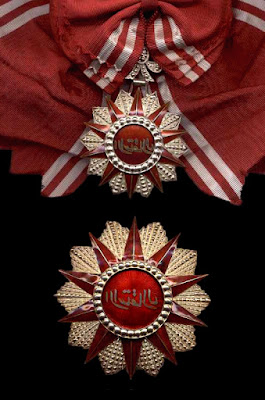 |
| Nishan al-Istiqlal, Type I - Grand Cordon, breast star (below), sash and sash badge (above). |
National Order of the Leopard
 |
| Grand Cross of the National Order of the Leopard, Zaire |
The President of the Congo is the Grand Chancellor of the Order. Its administration is in the care of the Chancellor.
Ranks
The National Order of the Leopard is composed of five grades:
- Grand Cordon
- Grand Officer
- Commander
- Officer
- Knight
Order of the Yugoslav Star
Order of the Yugoslav Star (Croatian: Orden jugoslavenske zvijezde; Serbian: Orden jugoslovenske zvezde; Slovene: Red jugoslovanske zvezde; Macedonian: Орден југословенска ѕвезда) was the highest National order of merit awarded in Yugoslavia. It was divided into four classes. The highest class, the Yugoslav Great Star was the highest state decoration awarded in Yugoslavia. The order was mostly awarded to foreign heads of state for the development and strengthening of peace and cooperation between nations.
The Order of the Yugoslav Star was also the second highest order of merit in Serbia and Montenegro.
History
Order of the Yugoslav Star was founded by the President of Yugoslavia Josip Broz Tito on 1 February 1954 and had three Classes. Law on Decorations was amended on 1 March 1961, so from then on, the Order had four Classes:
- Yugoslav Great Star — highest decoration in SFR Yugoslavia
- Yugoslav Star with Sash (before 1961 Order of the Yugoslav Star, I Class) — 6th highest decoration in SFR Yugoslavia
- Yugoslav Star with Golden Wreath (before 1961 Order of the Yugoslav Star, II Class) — 14th highest decoration in SFR Yugoslavia
- Yugoslav Star on Cravat (before 1961 Order of the Yugoslav Star, III Class) — 24th highest decoration in SFR Yugoslavia
After the dissolution of SFR Yugoslavia, Federal Republic of Yugoslavia (and later Serbia and Montenegro) continued to use some of the decorations of former Yugoslavia, among them Order of the Yugoslav Star. In the Federal Republic of Yugoslavia, Order of the Yugoslav Star was the second highest order after the Order of Yugoslavia. During this time the four Classes of the order were named:
- Yugoslav Great Star — 2nd highest decoration in FR Yugoslavia (after the Order of Yugoslavia)
- Yugoslav Star, I Class — 7th highest decoration in FR Yugoslavia
- Yugoslav Star, II Class — 20th highest decoration in FR Yugoslavia
- Yugoslav Star, III Class — 31st highest decoration in FR Yugoslavia
Recipients
The Order was usually awarded to foreign heads of state and other distinguished foreigners who visited Yugoslavia. Up to 1985, the Yugoslav Great Star was awarded 127 times of which 115 to foreigners and 12 to Yugoslav citizens.



